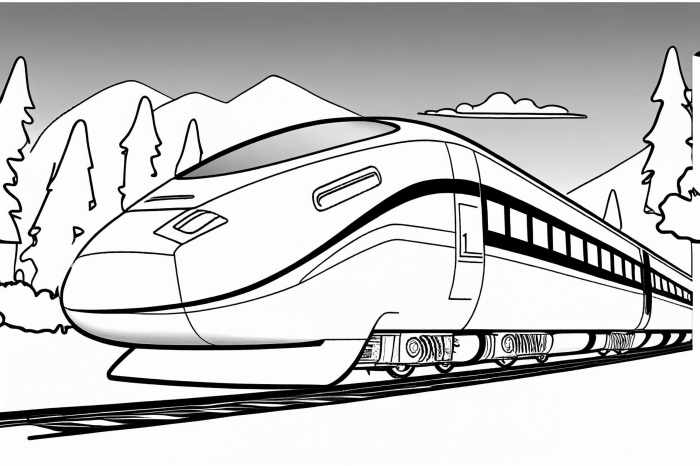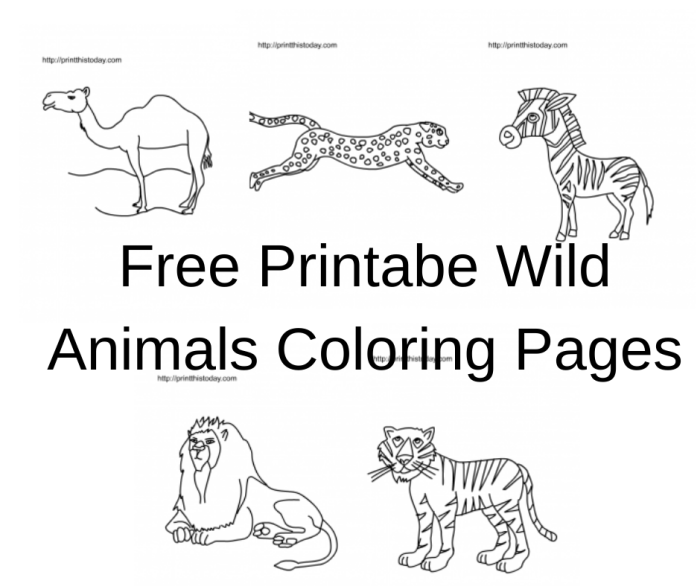Popularity and Trends of Train Coloring Book Pages: Coloring Book Pages Of Trains

Coloring book pages of trains – The enduring appeal of trains, coupled with the resurgence of adult coloring books, has created a niche market for train-themed coloring pages. These pages cater to a diverse audience, spanning various age groups and artistic preferences, reflecting broader trends in the coloring book industry. The market’s dynamism is shaped by evolving design styles, technological advancements in printing, and the ever-changing preferences of consumers.Train coloring pages enjoy consistent popularity, driven by the inherent fascination with trains across different cultures and generations.
This fascination stems from the romanticism associated with travel, the intricate mechanics of trains, and their historical significance. The market reflects this enduring interest through diverse offerings, ranging from simple designs for young children to complex, detailed illustrations for adults.
Age Demographics Interested in Train Coloring Pages, Coloring book pages of trains
Children, particularly boys aged 3-8, represent a significant portion of the market for train coloring pages. Simpler designs with bold Artikels and large spaces for coloring appeal to this age group, fostering creativity and fine motor skill development. However, the appeal extends beyond childhood. Adults, particularly those with an interest in transportation, history, or detailed artwork, also constitute a notable segment of the market.
Coloring book pages featuring trains offer a diverse range of designs, from classic steam locomotives to modern high-speed rail. A readily available source for such pages, and many other themes, can be found at a website offering free coloring book pages ; this resource provides a vast selection for various interests. The availability of these free resources significantly enhances the accessibility of train-themed coloring activities for children and enthusiasts alike.
The intricate details and complexity found in some adult-oriented train coloring pages offer a therapeutic and engaging activity for stress relief and creative expression. This demographic often prefers realistic or vintage-style illustrations.
Comparison to Other Transportation-Themed Coloring Books
While airplanes, cars, and ships also feature prominently in transportation-themed coloring books, train coloring pages maintain a strong position. The unique aesthetic of trains, with their long, sleek bodies, multiple carriages, and intricate details like wheels and smokestacks, provides rich visual material for artists. This inherent visual complexity allows for a wider range of artistic styles and design possibilities compared to, say, simpler car designs.
While the overall market for transportation-themed coloring books is competitive, the specific niche of train coloring pages benefits from its distinct visual appeal and cultural significance. For instance, iconic steam locomotives or high-speed bullet trains each offer a unique visual identity, readily appealing to different interests.
Styles of Train Coloring Pages
Several distinct styles cater to diverse preferences. Realistic train coloring pages often feature highly detailed illustrations, accurately depicting the intricate mechanics and features of various train models. These are often preferred by older children and adults who appreciate accuracy and detail. Cartoonish train coloring pages, on the other hand, utilize simplified, often anthropomorphized, designs, making them ideal for younger children.
These designs are often brighter and more playful, focusing on fun and engaging characters. Vintage-style train coloring pages evoke a sense of nostalgia, depicting classic locomotives and railway scenes from bygone eras. These designs often feature muted color palettes and a focus on historical accuracy, appealing to those with an interest in history and classic design. The availability of these varied styles ensures a broad appeal across different age groups and artistic tastes.
Design Elements of Train Coloring Pages

Successful train coloring pages engage children and adults alike through a thoughtful combination of design elements. These elements work together to create visually appealing and stimulating pages that encourage creativity and relaxation. Careful consideration of detail, color palettes, and the use of negative space are key to achieving this.
The level of detail in a train coloring page significantly impacts its appeal. Simpler designs, featuring basic Artikels of trains, are suitable for younger children with limited fine motor skills. More intricate designs, with detailed components like rivets, windows, and smoke stacks, challenge older children and adults, offering a more rewarding coloring experience. The choice of train type also plays a crucial role.
A variety of trains, each with unique characteristics, keeps the coloring experience fresh and interesting.
Types of Trains Depicted
Train coloring pages commonly feature a diverse range of trains, catering to different interests and age groups. Steam locomotives, with their intricate mechanisms and nostalgic appeal, are a popular choice. Their complex designs provide ample opportunity for detailed coloring. Modern high-speed trains, sleek and streamlined, offer a contrasting aesthetic, appealing to those interested in contemporary technology. Freight trains, with their long lines of carriages carrying diverse cargo, present opportunities for creative color schemes and storytelling through the depiction of the goods being transported.
The inclusion of different train types ensures variety and caters to a broader audience.
Effective Use of Negative Space
Negative space, the area surrounding the main subject, is a crucial design element in coloring pages. Effective use of negative space enhances the visual impact of the train by creating a sense of balance and allowing the train to stand out. For instance, a simple design might depict a train against a large, uncluttered background, allowing the train’s details to be the focal point.
More complex designs might incorporate smaller elements in the negative space, such as landscapes, buildings, or other railway features, creating a richer and more engaging scene. Clever use of negative space avoids a cluttered look, keeping the page visually appealing and easy to color.
Impact of Design Elements on Visual Appeal
| Design Element | Description | Impact on Visual Appeal | Example |
|---|---|---|---|
| Level of Detail | Complexity of train features (e.g., rivets, windows) | High detail offers a challenging and rewarding experience; simpler designs are suitable for younger children. | A detailed steam locomotive versus a simplified cartoon train. |
| Color Palette | Range and combination of colors used. | Vibrant, contrasting colors create energy; muted tones offer a calmer aesthetic. | A page using bright primary colors versus one using earth tones and pastels. |
| Train Type | Variety of trains depicted (e.g., steam, high-speed, freight). | Diverse train types increase interest and cater to different preferences. | A page featuring a steam locomotive, a bullet train, and a freight train. |
| Negative Space | Area surrounding the train. | Effective use of negative space enhances visual balance and emphasizes the train. | A train depicted against a large, uncluttered background versus a train surrounded by many small details. |
User Experience and Accessibility of Train Coloring Pages

A positive user experience is paramount for the success of any coloring book, especially one targeting children. Clear, engaging designs coupled with accessibility features ensure a broad appeal and inclusive enjoyment. This section explores the design considerations necessary to create train coloring pages that are both enjoyable and usable for a wide range of individuals.
The simplicity and clarity of a coloring page directly impact its usability. A cluttered or overly complex design can be frustrating, particularly for younger children or those with limited fine motor skills. Conversely, a well-designed page provides a satisfying and rewarding coloring experience, encouraging creativity and focus. Accessibility for users with visual impairments also requires careful consideration, ensuring the design is inclusive and enjoyable for everyone.
Design Considerations for Clear and Easy-to-Follow Designs
Several factors contribute to creating user-friendly train coloring pages. These include line weight, image complexity, and color palette selection. Thick, bold lines are easier to follow for small hands and those with visual impairments. Simple, uncluttered designs are less overwhelming and easier to complete, preventing frustration. A limited, high-contrast color palette can improve the overall visual clarity and appeal.
Accessibility Considerations for Users with Visual Impairments
Users with visual impairments may benefit from several design modifications. High contrast between the lines and the background is crucial. Thick, bold Artikels are easier to trace and color within. Simpler designs with fewer intricate details are less visually demanding. Furthermore, the use of textured paper can provide tactile feedback, aiding in coloring and understanding the image.
Guidelines for Designing User-Friendly Train Coloring Pages
Creating inclusive and enjoyable train coloring pages requires adherence to specific guidelines. These guidelines ensure accessibility and a positive user experience for all.
- Use thick, bold lines (at least 3-4mm) for easy tracing and coloring.
- Employ a limited color palette with high contrast between lines and background.
- Keep designs simple and uncluttered, avoiding excessive detail.
- Consider incorporating tactile elements for users with visual impairments (e.g., textured paper).
- Use large, clear fonts for any accompanying text.
- Ensure sufficient spacing between elements to prevent overcrowding.
Comparison of Two Example Train Coloring Pages
Let’s compare two hypothetical train coloring pages to illustrate the principles discussed above. Page A features a detailed, intricately designed steam train with numerous small components and thin lines. Page B, conversely, presents a simpler, cartoonish train with bold Artikels and fewer details. Page A, while visually appealing to some, might prove challenging for young children or individuals with visual impairments due to the fine details and thin lines.
Page B, with its bold lines and simplified design, offers a more accessible and user-friendly experience, reducing frustration and enhancing enjoyment.
User Queries
What are the best tools for creating train coloring pages?
Digital tools like Adobe Illustrator or Photoshop are popular, but traditional mediums like pencils, inks, and watercolors also yield excellent results.
Where can I find royalty-free images of trains for my coloring pages?
Several stock photo websites offer royalty-free train images, or you can create your own original artwork.
How can I make my train coloring pages more appealing to older children and adults?
Incorporate more intricate details, realistic styles, or complex themes to engage older audiences.
What are some ways to promote my train coloring pages?
Utilize online platforms like Etsy, social media marketing, and collaborations with relevant blogs or websites.

